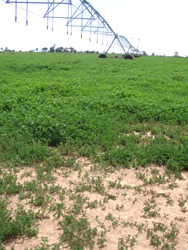4.2.2.2 Is the irrigation application uniform?
Return to Main Menu | Return to Step 4 | Return to Step 4.2.2 | Next Step
Reference
Foley, J. (2005) "Centre Pivot and Lateral Move Machines" in Cotton Catchment Communities Cooperative Research Centre, Section 4.6 (external link).
Page top
Uniformity of application, or distribution uniformity refers to how evenly the irrigation water is applied across the pivot circle. With poor uniformity some parts will be either under or over-irrigated. Factors that can contribute to non-uniformity include:
Uniformity is measured by comparing the depth of water applied at various points within the pivot circle. Catch cans are used to measure application depths to calculate uniformity. The measurement and calculation process is reasonably complex, and perhaps beyond what most farmers are prepared to do. However, measurement of the depth of application at a number of points with catch cans and comparison with what is supposed to be applied gives an indication. For more information see: the DPI Agnote Centre Pivot Performance Check. |
 is the irrigation uniform? |
Foley, J. (2005) "Centre Pivot and Lateral Move Machines" in Cotton Catchment Communities Cooperative Research Centre, Section 4.6 (external link).


